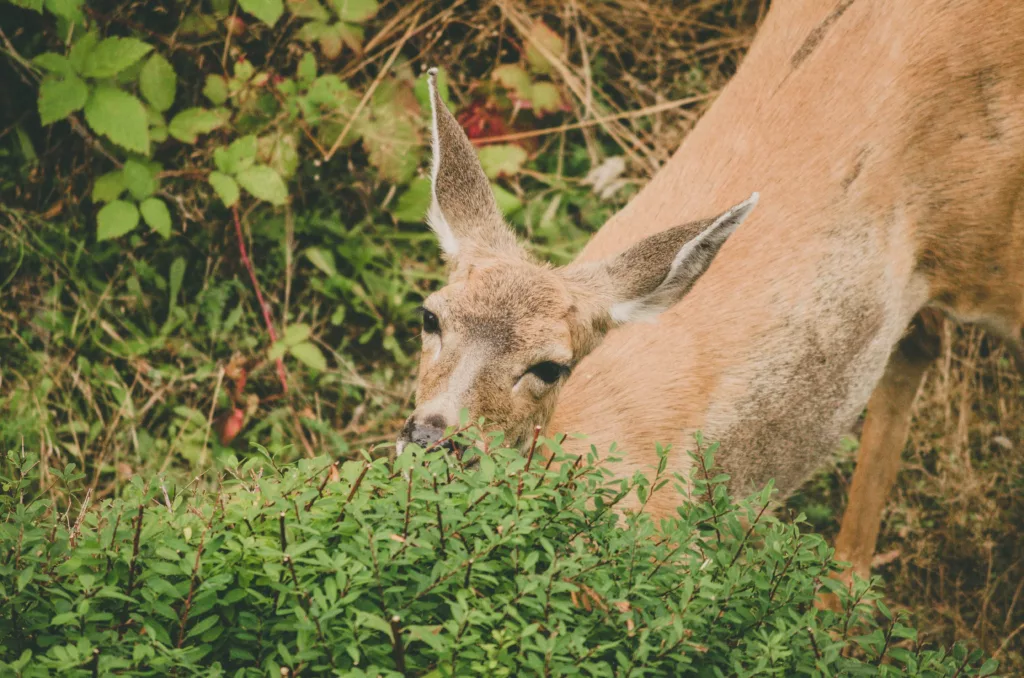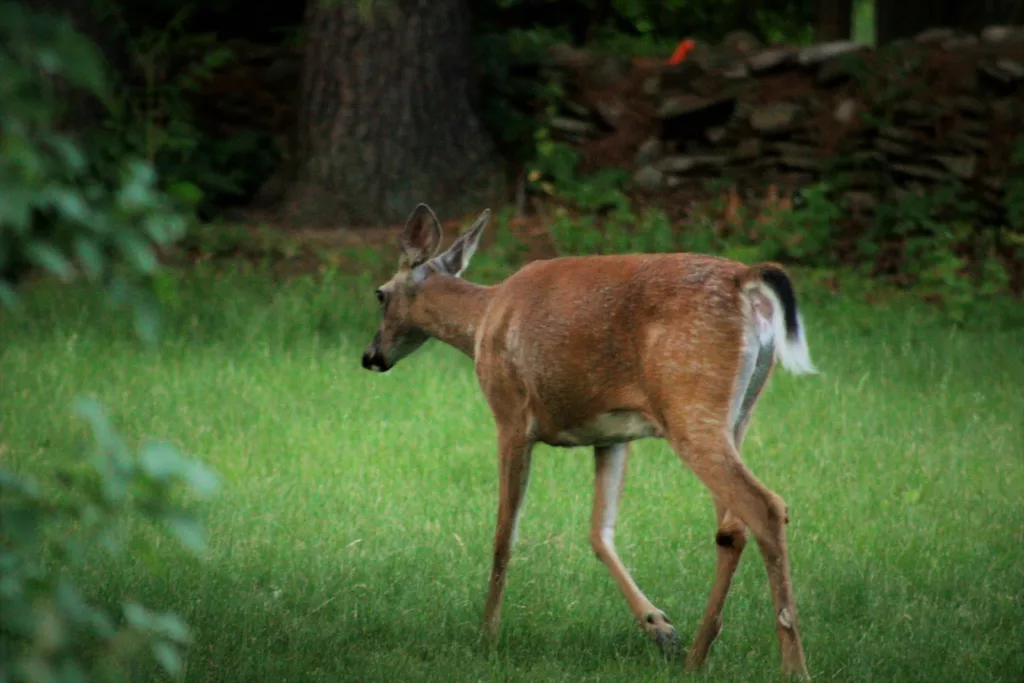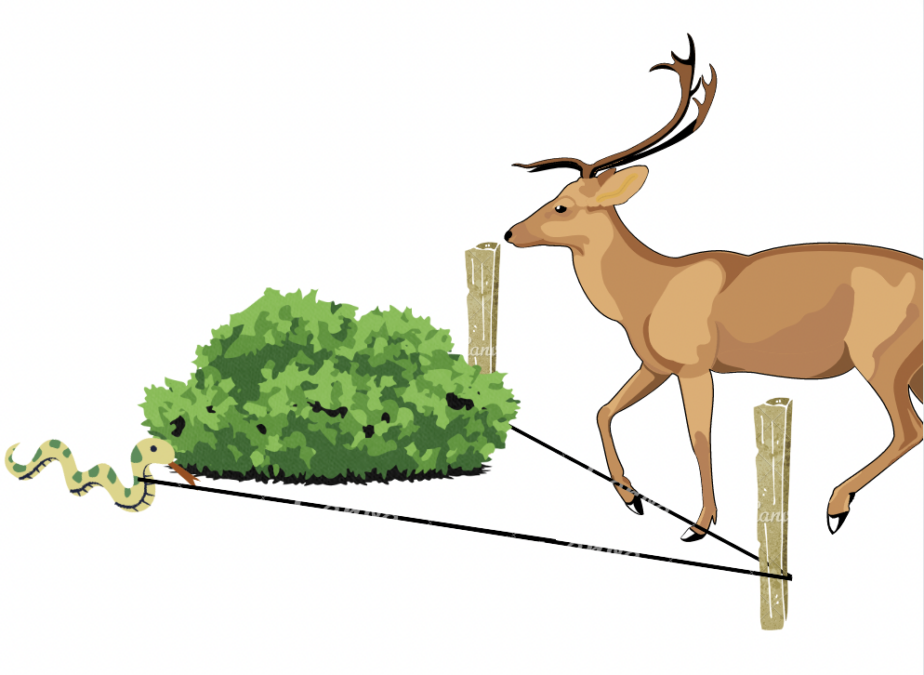This post may contain affiliate links. If you use these links to buy something we may earn a commission. Thanks.
Several household items can repel or scare deer by stimulating their senses, such as sight, when using motion or reflections.
Movement signifies to a deer that space is occupied, and when combined with sounds and noises it’s all the more convincing.
See: 11 Easy Noises & Sounds To Scare Deer Away For Good
In this post, you’ll find effective deer deterrent tactics beyond bad-smelling homemade deer repellents.

What household items repel deer?
Not just any household item can sit outside and work wonders to defend your garden from deer. Specific objects and items are able to stimulate a deer’s senses which is what will repel them from a given space.
A variety of household objects that can move via the wind, or create noise, is the most effective deer repellent. Any unfamiliar object with a motion, reflection, or sound will keep deer from entering your space if they see or hear it.
Deer are repelled by unfamiliar sights, sounds, or both. The keyword is ‘unfamiliar,’ eventually, all tactics or objects will become familiar to a deer if you make the mistake of “setting it and forgetting it.”
So whatever you do, don’t set up a single tactic and expect it to work forever. This same idea applies to all smell and taste -based deer repellents.
For every tactic you set up, expect it to work for 1-2 weeks and replace it with a new tactic before the deer become comfortable.
The goal of this post is to provide you with as many different ideas as possible so you can repel deer long-term without the need for an expensive fence.
Below are your best options for repelling deer (on an ever-changing schedule) to protect, perhaps, an unfenced garden.
Related: Schedule to Keep Deer Out of The Garden Without A Fence

Order deer-resistant shrubs, herbaceous perennials, bulbs, roses, and ground covers all in one place.
Clothed scarecrow
Use any sacrificial and flowy clothing to dress a scarecrow, and voila, the wind will wave the clothes around and create a motion that’ll catch the eye of any prying deer.
Pair this and all other options below with noises (either motion-sensing or randomized) and you’ll have a foolproof defense.
To keep this tactic effective, relocate the scarecrow every time you go outside to visit your garden.
Even better, add another scarecrow, perhaps a silk scarf on a post to change things up.
Silk scarf on a post (or a flag or windsock)
A simplified version of a scarecrow is a simple pole with a lightweight scarf or fabric attached to it.
A flag or windsock of your choice will also do the job.
When using this tactic, I recommend setting it up and adding another one in a few days.
Then after a few more days, you can group them all together. This keeps the tactic working as every time the deer visit they will still see the same movement, but also change.
After a few more days, separate all the posts to new locations once again.
- Once it’s been about 2 weeks, move on to the next tactic so the deer don’t become familiar with your “scarf” crow.
Hanging CD’s
Next up, hang a handful of CDs or old disks on some fishing line and hang them in a tree, or on a structure.
If you don’t have either of those, use a pole and hammer it into the ground at a 45-degree angle and hang the CDs from the top.
Similar to the scarf crow, you’ll want to relocate this in a few days and also pair it with a new noise.
Don’t slowly phase your “crows” into the hanging CDs—rather, change it all up completely. Make the sounds and visuals into something completely new—Into something the deer have never seen before.
Pinwheel
Pinwheels are typically used as bird deterrents, but if used for a short time, they are also effective for repelling deer from coming too close.
If you like pinwheels, consider getting a few options to change up your deer defenses.
Metal pinwheeling like this one will eventually become squeaky! You’ll have both sound and motion to deter deer in one apparatus.
While beautiful for you, the eyes on an owl pinwheel can also be an uneasy sight for deer.
Balloons
All previous objects rely on a post or stake to stand—a balloon is much different in the way it moves.
Because of that, I recommend using this method in between your rotation of still-post objects.
Even without helium, balloons can repel deer as long as they are visible at a distance. Give your ballon a long string and allow the wind gusts to flail as desired.
With noise, this can be pretty frightening. The randomized and off movement of a light balloon is sure to be unfamiliar enough to keep deer from entering your yard.
Different-shaped balloons
Plain balloons will do the job, but when it comes time to switch it up, you’ll be looking for other options. If you fail to change enough, your plants will eventually be demolished overnight.
Next time “balloons” are worked into your deer deterrent schedule, choose balloons that offer new shapes, sizes, and faces!
Here are some wild examples of what I mean:
- Long spiral balloons
- Scary face balloons
- Animal balloons
- Dinosaur balloon
- Spikey balloons
- Spiderman balloon
Motion activated sprinklers
A hose is a likely household item you have for your garden already.
All you’ll need is a motion-sensing attachment to set off sprinklers to rid any oncoming deer.
Face it in the direct deer are most likely to come from and they’ll be startled enough to run off.
Use this for about a week or two then take it down so they don’t figure out how harmless spraying water is.
Rubber snake or motion-activated snake
Okay, this may not be a household item, like the last few options, but a very effective option that can offer motion.
A rubber snake can deter deer both by sight and sound.
To make a rubber snake move, you could optionally set up a “tripwire.”
- Attach the snake to a fishing line
- Attach the fishing line to a pole about a foot off the ground
- Have another pole on the other side of the spot the deer would walkthrough where the line would hook
- Have the snake rest in front of the tripwire

This article was originally published on foodforestliving.com. If it is now published on any other site, it was done without permission from the copyright owner.
Once a deer walks through the trip wire, the snake will move and you could also put on a motion-activated snake sound.
Using a solar motion-sensing sound speaker, record snake noises and pair this sound deterrent with the rubber snake in a location where deer are likely to enter your property.
Scare tape
Scare tape is a reflective mylar tape and you can use this in two ways to create motion for an effective deer deterrent.
- Put a piece of mylar tape on a pole to flail about in the wind
- Put a loose strip of tape vertically between two points, and the wind will rattle the tape in a verticle standing position (rather than a flag position)
This 500ft roll of reflective “bird scare” tape will last you a long time.
Decoy coyote or fox
Finally, you probably don’t have this item unless you’re a hunter, but decoy animals can be scary for a deer to stumble upon when gracefully walking about.
This is less about being a far-sighted motion deterred, and more about being a startling scare if they made the “wrong” choice of ignoring your motion deterrent and coming on in any way.
Is scaring deer away a lot of work?
Deer deterrents can be a lot of work, but if you’re outside often for your garden anyway, all you’ll need to do to make it easier is put together a deer deterrent “toolbox”—a bin where you can store all your accessories and options for scaring deer.
If setting up and taking down deer deterrents becomes too laborious or time-consuming, consider automated options that are easily switched without moving things around, or invest in an effective deer fence.
Up Next:
Protect Your Plants From Deer Without Shooting & Freezing
Will Deer Chew Through Plastic fencing? How To Avoid Damage
Recent Posts
There’s no shortage of full-sun ground covers for zone 4 climates! Each plant in this list can withstand the frigid temperatures and also enjoy the hot sun in summer. Full sun means that a plant...
There's no shortage of full sun ground covers, not even in zone 3! Zone 3 climates offer hot but short-lived summers and very cold winters. So each plant in this list can withstand the frigid...
